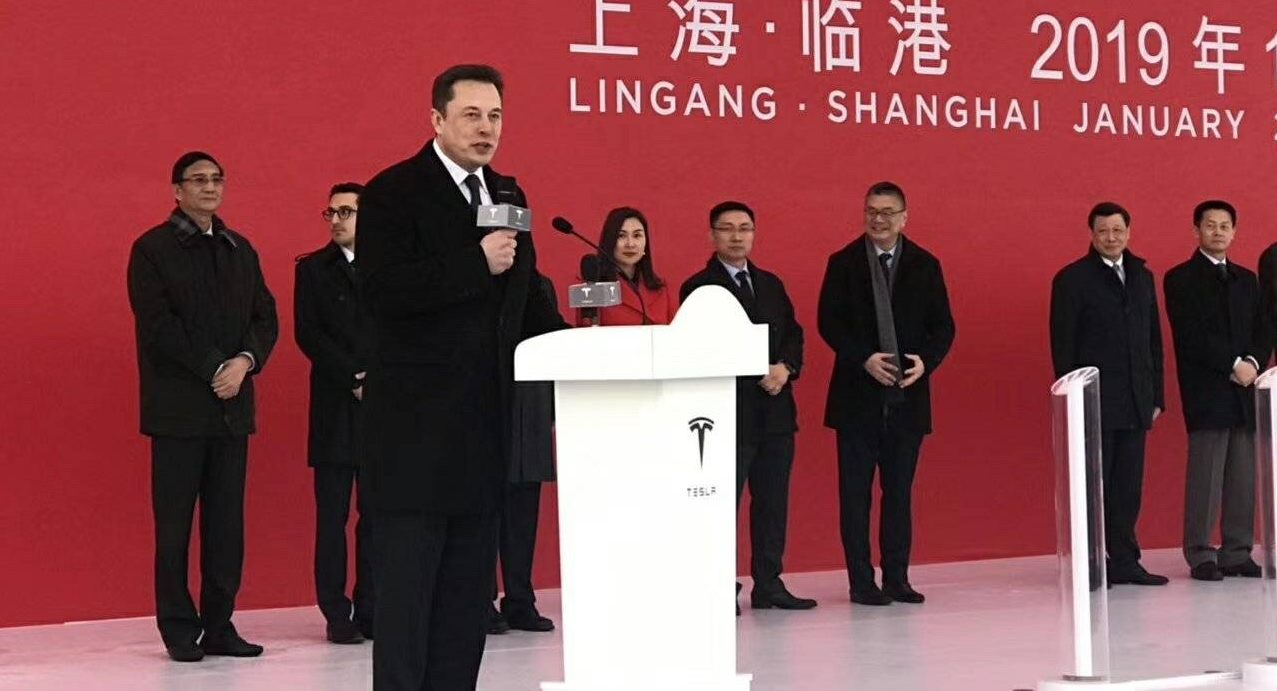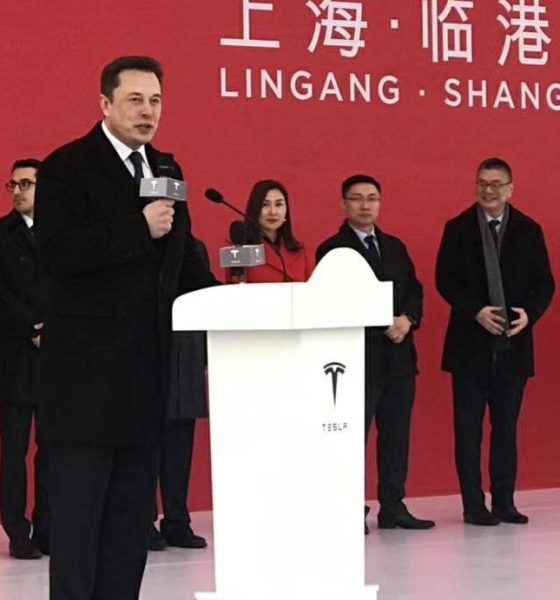

Investor's Corner
Tesla’s Gigafactory 3 is encouraging China’s local EV makers to be more competitive
Within the next few months, Tesla would begin exporting the Model 3 Performance and Long Range Model 3 AWD to the Chinese market. By the end of the year, the electric car maker aims to have the first Model 3 produced in Gigafactory 3, which will be equipped with both battery and electric car assembly lines.
There is a very good reason why the automotive industry is putting a lot of effort into saturating China. The country, after all, is the largest automobile market globally, both in terms of demand and supply. In 2017 alone, the country produced almost 25 million passenger cars and roughly 4 million commercial vehicles. The country is also a large market for electric vehicles, with sales of EVs hitting the 1 million mark in 2018, and estimates indicating that up to 2 million EVs could be sold in China by 2020.
Amidst this competitive car market lies Tesla and the upcoming Gigafactory 3. So far, Tesla’s electric cars — the Model S and Model X — have been competing in the Chinese market as higher-priced, premium alternatives to locally-made EVs. Tesla has been pretty successful in this sense, becoming a brand largely associated with status and quality, similar to other premium products such as the Apple iPhone. With Gigafactory 3, though, Tesla is stepping away from this strategy, as the facility is looking to produce the Model 3 and Model Y — affordable electric cars that can attack the much-larger, lower-end of the market.
While the presence of Tesla’s massive facility in Shanghai could result in more intense competition, though, some of the country’s local electric car companies have stated that they welcome the arrival of the Silicon Valley-based company nonetheless. In a statement to Xinhua News, Cui Dongshu, secretary general of the China Passenger Car Association, noted that the arrival of Gigafactory 3 would likely encourage local carmakers to step up their game. This, of course, benefits consumers.
“Tesla’s China production will have a ‘catfish effect’ in the country’s auto industry, pushing domestic carmakers to speed up their technological upgrading,” Cui said.
Jin Guoqing, deputy director of Chang’an Automobile, an automotive dynamics research institute, stated that his company would push its efforts even further now that Tesla has arrived in China, particularly as his firm targets a different price bracket and demographic compared to the American carmaker.
“We shall amplify our advantages to the most,” Jin said.
Legacy carmakers that are also attempting to breach the country’s lucrative and growing auto market are raising the stakes for their competition as well. Mercedes-Benz Parts Manufacturing & Service Ltd., for one, also inaugurated its first factory outside Europe last October. Just like Gigafactory 3, Mercedes-Benz’ factory is being built on the Lingang Area. BMW, on the other hand, also announced last October that it would be increasing its stake in BMW Brilliance Automotive, a joint venture located in in the northeastern city of Shenyang.
Ultimately, the arrival of Tesla’s Gigafactory 3 would likely boost the country’s electric car initiatives. Thus, apart from allowing Tesla to tap into what could very well be a lucrative market, Gigafactory 3 could also be the trigger that pushes even more innovation forward in the country. With vehicles such as the Model 3 and the Model Y saturating China, after all, competitors would be wise to come up with vehicles that are just as good or even better than Tesla’s electric cars.
Elon Musk, for his part, has expressed his high hopes for the facility. During an interview after the groundbreaking event, Musk stated that he has been very impressed with the construction capabilities of China so far. In his speech at the groundbreaking ceremony, Musk urged the country’s most driven workers to apply for a post in Gigafactory 3, even noting that maybe, just maybe, someone working in Gigafactory 3 could succeed him someday.
“I do want to emphasize that there’s no limit on the potential. One day, somebody could join us — a junior engineer here at Tesla Shanghai Gigafactory — and ultimately, maybe have my job someday,” Musk said.

Investor's Corner
Tesla stock closes at all-time high on heels of Robotaxi progress

Tesla stock (NASDAQ: TSLA) closed at an all-time high on Tuesday, jumping over 3 percent during the day and finishing at $489.88.
The price beats the previous record close, which was $479.86.
Shares have had a crazy year, dipping more than 40 percent from the start of the year. The stock then started to recover once again around late April, when its price started to climb back up from the low $200 level.
This week, Tesla started to climb toward its highest levels ever, as it was revealed on Sunday that the company was testing driverless Robotaxis in Austin. The spike in value pushed the company’s valuation to $1.63 trillion.
Tesla Robotaxi goes driverless as Musk confirms Safety Monitor removal testing
It is the seventh-most valuable company on the market currently, trailing Nvidia, Apple, Alphabet (Google), Microsoft, Amazon, and Meta.
Shares closed up $14.57 today, up over 3 percent.
The stock has gone through a lot this year, as previously mentioned. Shares tumbled in Q1 due to CEO Elon Musk’s involvement with the Department of Government Efficiency (DOGE), which pulled his attention away from his companies and left a major overhang on their valuations.
However, things started to rebound halfway through the year, and as the government started to phase out the $7,500 tax credit, demand spiked as consumers tried to take advantage of it.
Q3 deliveries were the highest in company history, and Tesla responded to the loss of the tax credit with the launch of the Model 3 and Model Y Standard.
Additionally, analysts have announced high expectations this week for the company on Wall Street as Robotaxi continues to be the focus. With autonomy within Tesla’s sights, things are moving in the direction of Robotaxi being a major catalyst for growth on the Street in the coming year.
Elon Musk
Tesla needs to come through on this one Robotaxi metric, analyst says
“We think the key focus from here will be how fast Tesla can scale driverless operations (including if Tesla’s approach to software/hardware allows it to scale significantly faster than competitors, as the company has argued), and on profitability.”

Tesla needs to come through on this one Robotaxi metric, Mark Delaney of Goldman Sachs says.
Tesla is in the process of rolling out its Robotaxi platform to areas outside of Austin and the California Bay Area. It has plans to launch in five additional cities, including Houston, Dallas, Miami, Las Vegas, and Phoenix.
However, the company’s expansion is not what the focus needs to be, according to Delaney. It’s the speed of deployment.
The analyst said:
“We think the key focus from here will be how fast Tesla can scale driverless operations (including if Tesla’s approach to software/hardware allows it to scale significantly faster than competitors, as the company has argued), and on profitability.”
Profitability will come as the Robotaxi fleet expands. Making that money will be dependent on when Tesla can initiate rides in more areas, giving more customers access to the program.
There are some additional things that the company needs to make happen ahead of the major Robotaxi expansion, one of those things is launching driverless rides in Austin, the first city in which it launched the program.
This week, Tesla started testing driverless Robotaxi rides in Austin, as two different Model Y units were spotted with no occupants, a huge step in the company’s plans for the ride-sharing platform.
Tesla Robotaxi goes driverless as Musk confirms Safety Monitor removal testing
CEO Elon Musk has been hoping to remove Safety Monitors from Robotaxis in Austin for several months, first mentioning the plan to have them out by the end of 2025 in September. He confirmed on Sunday that Tesla had officially removed vehicle occupants and started testing truly unsupervised rides.
Although Safety Monitors in Austin have been sitting in the passenger’s seat, they have still had the ability to override things in case of an emergency. After all, the ultimate goal was safety and avoiding any accidents or injuries.
Goldman Sachs reiterated its ‘Neutral’ rating and its $400 price target. Delaney said, “Tesla is making progress with its autonomous technology,” and recent developments make it evident that this is true.
Investor's Corner
Tesla gets bold Robotaxi prediction from Wall Street firm
Last week, Andrew Percoco took over Tesla analysis for Morgan Stanley from Adam Jonas, who covered the stock for years. Percoco seems to be less optimistic and bullish on Tesla shares, while still being fair and balanced in his analysis.

Tesla (NASDAQ: TSLA) received a bold Robotaxi prediction from Morgan Stanley, which anticipates a dramatic increase in the size of the company’s autonomous ride-hailing suite in the coming years.
Last week, Andrew Percoco took over Tesla analysis for Morgan Stanley from Adam Jonas, who covered the stock for years. Percoco seems to be less optimistic and bullish on Tesla shares, while still being fair and balanced in his analysis.
Percoco dug into the Robotaxi fleet and its expansion in the coming years in his latest note, released on Tuesday. The firm expects Tesla to increase the Robotaxi fleet size to 1,000 vehicles in 2026. However, that’s small-scale compared to what they expect from Tesla in a decade.
Tesla expands Robotaxi app access once again, this time on a global scale
By 2035, Morgan Stanley believes there will be one million Robotaxis on the road across multiple cities, a major jump and a considerable fleet size. We assume this means the fleet of vehicles Tesla will operate internally, and not including passenger-owned vehicles that could be added through software updates.
He also listed three specific catalysts that investors should pay attention to, as these will represent the company being on track to achieve its Robotaxi dreams:
- Opening Robotaxi to the public without a Safety Monitor. Timing is unclear, but it appears that Tesla is getting closer by the day.
- Improvement in safety metrics without the Safety Monitor. Tesla’s ability to improve its safety metrics as it scales miles driven without the Safety Monitor is imperative as it looks to scale in new states and cities in 2026.
- Cybercab start of production, targeted for April 2026. Tesla’s Cybercab is a purpose-built vehicle (no steering wheel or pedals, only two seats) that is expected to be produced through its state-of-the-art unboxed manufacturing process, offering further cost reductions and thus accelerating adoption over time.
Robotaxi stands to be one of Tesla’s most significant revenue contributors, especially as the company plans to continue expanding its ride-hailing service across the world in the coming years.
Its current deployment strategy is controlled and conservative to avoid any drastic and potentially program-ruining incidents.
So far, the program, which is active in Austin and the California Bay Area, has been widely successful.








